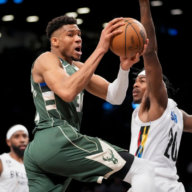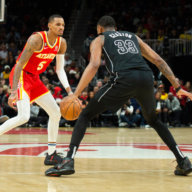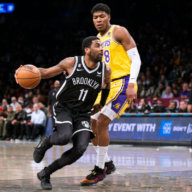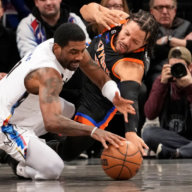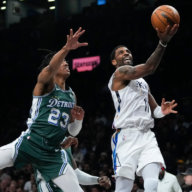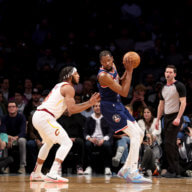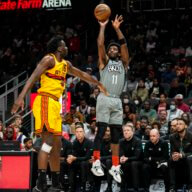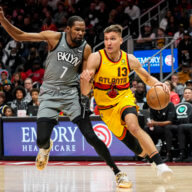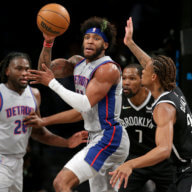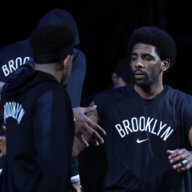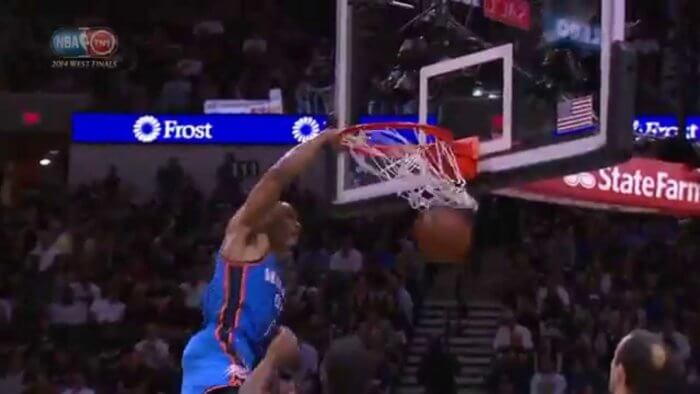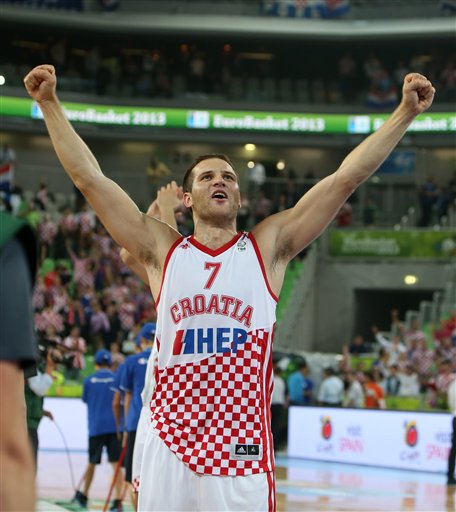So, just to recap: In anticipation of Draft Night, last week, I looked back at the Nets’ history with lottery picks. When examining how the Nets fared with picks number one through four, we saw that the Nets never pulled away as a true winner with those picks – with Derrick Coleman and Kenny Anderson have amazing potential but ultimately flaming out, and Chris Morris and Dennis Hopson never playing at a level that justified their high selection. Now, we’re looking at the Nets remaining lottery picks – the slots where good talent can be found, but is even less of a guarantee than the top four picks.
In their franchise history, the Nets have never picked fifth or sixth, so let’s jump ahead to…
With the seventh pick in the NBA Draft, the Nets select Tim Thomas (1997) and Eddie Griffin (2001): Well isn’t this interesting… the two times the Nets picked seventh also marked the two times they traded their lottery picks for other players. And in both cases, the players acquired for their picks went on to become key players in the team’s first NBA finals season in 2001-02.
Tim Thomas has been a nice, well-traveled player throughout his NBA career, but I firmly believe the Nets did better for themselves after trading him, Jim Jackson, Eric Montross and Anthony Parker to the Philadelphia 76ers for No. 2 pick Keith Van Horn, Lucious Harris, Michael Cage and Don MacLean. MacLean and Cage had a rather inconsequential stint with the Nets, but Harris and Van Horn were both productive players for the organization. And since this is a look at draft picks specifically, let look at this from a Van Horn vs. Thomas perspective. Van Horn was never the “Great White Hope” or “Next Larry Bird” as he was labeled by some prior to the start of his NBA career, but what he ultimately was, especially in the first few years of his tenure in New Jersey, a scorer for a team that badly needed one. Think of him as a more consistent version of Yi Jianlian – a big man with a fantastic shooting touch (36 percent on threes for his career), but who struggled in terms of defense, rebounding and toughness. He had issues first getting along with his point guard, Stephon Marbury (and who’s side in the fight are you really going to take knowing what you know now about Starbury?) and he was also reportedly called out a few times for his lack of toughness during the Nets first Finals run in 01-02, but overall, he was a consistent 19/8 guy for the first three years of his career, and his scoring abilities didn’t really start to decline until he was injured in 2000-01 and then came back playing in the Jason Kidd, “everyone gets to score” fast break system. Meanwhile, for all of Thomas’ athletic gifts, he never put together a full season that came close to what Van Horn did in a Nets uniform. His career has lasted longer than Van Horn’s but primarily because he’s been treated as a hired mercenary for playoff-bound teams the past few seasons. Nothing wrong with that, but the Nets were able to unload their pick in 1997 for a player that became a key part of their foundation. When you look at key players drafted after the seventh pick, the only glaring name is Tracy McGrady, who was a raw high school kid at the time, and who has gone on to have a great, albeit ultimately disappointing NBA career.
As for the 2001 pick, if the Nets had held on to Eddie Griffin, it would have been a pick marred by great tragedy. Griffin was as gifted as they got, and was a local boy to boot, playing high school ball in Philadelphia, and college ball at Seton Hall. But there were character issues for sure, which caused him slip to the Nets. And those character issues were not unfounded, as he bounced around the league for a few years, include a year where he signed back on with the Nets but never played because he was in rehab, before dying in a car crash in 2007. But instead of having to deal directly with the negativity associated with Griffin’s career, the Nets in term parlayed him into one of the organization’s all-time fan favorites, when they traded him to the Houston Rockets Richard Jefferson, Jason Collins and Brandon Armstrong. Granted, Gerald Wallace, Tony Parker and Gilbert Arenas were all picked after Armstrong (23) and Jason Collins got way too many minutes in Lawrence Frank’s system, but Richard Jefferson was an emotional leader for this franchise until he was traded away in 2008. While Jefferson will never be considered an “elite” player, he was a good enough scorer and a terrific defender. It’s very difficult to disparage this trade for the Nets considering they got three players for one, and that one player went on to have a troubling, then tragic career.
Final Verdict: Both wins for the Nets giving their circumstances. Given the hype and the fact that he was considered the second best player in the draft after Tim Duncan, it would have been nice for Van Horn to take his game to the next level, but it was a very good deal for the team. Meanwhile, the 2001 deal may go down as one of the franchise’s best trades of all time.
With the eighth pick in the NBA Draft, the Nets select Kerry Kittles (1996): This is a tough one for me. On one end, Kerry Kittles goes down as one my favorite Nets of all time. A solid three point shooter who ran the floor like a gazelle and played very good defense, Kittles was a solid part of the Nets back-to-back Finals team. If Courtney Lee could ever evolve into Kerry Kittles, something I think is possible, I would be more than happy as a Nets fan. But the problems with this selection is not necessarily with Kittles, but with who the Nets passed on. Namely Kobe Bryant. As rumor has it, Nets coach John Calipari was all set to take Bryant with the 8th pick, but was punked by Jerry West, who had plans to make a deal with the Charlotte Hornets for the 13th pick so Bryant would end up in Hollywood. Bryant’s family even reached out to Calipari and said Kobe wanted to play for the Lakers. And Calipari apparently had a conscious for the first time in his life, and went for Kittles. And while I loved Kittles, and Kobe Bryant didn’t start playing like the next Air Jordan until a few years into his career, how can I possibly get behind this pick when one of the greatest players of all time was a whiskers length away from calling the swamp his home? And its stories like these, ladies and gents, that make Nets fans perhaps the second most tortured fanbase in NBA history behind the Los Angeles Clippers.
Final Verdict: Bust. Let’s just hope if the Nets have a chance to take Evan Turner at No. 3, Rod Thorn isn’t talked out of it by somebody.
With the ninth pick the Nets select Ed O’Bannon (1995): Make the bad man stop. Okay, I’ll admit it. When Ed O’Bannon, the College Player of the Year, landed in the Nets lap at #9, I was feeling pretty cocky. I still remember Toronto fans booing Isiah Thomas for picking Damon Stoudamire instead of O’Bannon. Little did I know that O’Bannon’s rumored knee issues were as true and Thomas would go on to be pretty shrewd when it came to the draft (given he hadn’t traded the picks away natch).
O’Bannon is an amazing example of the bad luck the Nets have as an organization, and was a big reason I didn’t initially get excited when Brook Lopez fell into their laps a few years ago (more on that later). While the Nets had made their share of stupid picks in the past, O’Bannon falling to nine was considered a gift for the organization. But he only scored 6.9 points on 39 percent shooting (18 percent from three) his rookie season, and he went on to last just three seasons because he was too frail to play forward and too slow to play guard. And unlike Chris Douglas-Roberts, he didn’t have a Twitter account to build up a strong following.
Final Verdict: Bust.
With the tenth pick, the Nets select Brook Lopez (2008): Finally, something to get the stink of the past two picks off. Brook Lopez, as I alluded to a few paragraphs ago, is the anti Ed O’Bannon. He’s an example of something actually going right, and hopefully (knocking on wood) staying right for the Nets. While the Charlotte Bobcats are still trying to figure out what to do with DJ Augustin, the Nets reaped the benefits of the pre-draft criticism of Lopez that he wasn’t athletic enough to evolve much as a player. The Nets got themselves a legit NBA center. And while I can understand critics out there who don’t share my enthusiasm for Brook – who think he’s a nice player, but not one of the game’s best centers, even the biggest of Brook bashers can’t criticize the Nets as an organization for landing themselves a player of Lopez’s size and caliber with the 10th pick in the draft.
Final Verdict: A definitive win. When you consider where he was picked and the position he plays, Lopez may go down as the best draft pick in the team’s history.
With the eleventh pick, the Nets select Terrence Williams (2009): It’s a little early to give a final verdict on TWill since he was only picked a year ago. I will say for the first three to four months of the season, Williams looked like a total bust, regardless of who was picked after him (Tyler Hansborough, 13; Ty Lawson, 18; Darren Collison, 21; Omri Cassipi, 23; and Taj Gibson, 26, all deserve mention). But the final six weeks of the season, TWill looked like the versatile playmaker he was touted as coming into the draft. With a new coach, and some new players on the perimeter expected to land in Newark next year, Williams is going to be interesting to watch.
With the twelfth pick, the Nets select Mookie Blaylock (1989): I don’t think there are many NBA fans out there that associate Blaylock’s career with the Nets, but the Nets did in fact draft him in 1989, only to draft his successor at PG two years later with Kenny Anderson. So did the Nets pick wisely in unloading Blaylock in favor of Anderson, and could the Nets have done better in drafting another player with the 12th pick? The short answers are “maybe” and “yes.” Blaylock was solid enough in his three years with the Nets and during his seven seasons with the Atlanta Hawks, he was one of the NBA’s most solid and underappreciated PGs. His 93-94 season was especially eye opening, when he put up 13.8 points, 9.7 assists, 2.6 steals, 5.2 rebounds on 33 percent from three. Those are pretty nice numbers for a point guard. But Anderson had the look of a budding superstar in his first full season in Jersey, and who knows what he COULD have become if he wasn’t such a headcase – a recurring theme for the Nets and their draft picks. Then consider who the Nets received for Blaylock – Rumeal Robinson, a decent but unspectacular bench player who was eventually traded again a year later for Johnny Newman. The final thing I don’t like about this pick is who was taken after Mookie – namely Tim Hardaway one pick later at #12, and Shawn Kemp (17), who’s legacy may be unfairly tarnished by how fat and out-of-shape he was at the end of his NBA run. But if I could play fantasy basketball for a second and imagine a starting rotation in 92-93 with Kemp, Derrick Coleman, Anderson and Drazen Petrovic (we could even afford to have Chris Morris there at the three). Oh man… And it’s not even like 92-93 was Kemp’s best season (his 95-96 campaign of 19.6 points, 11.4 rebounds, 1.6 blocks, 1.2 steals on 56 percent shooting takes the cake for that). And I haven’t even compared Hardaway’s career as a PG to Blaylock and Anderson’s. Anyone, I’m thankful this is the last pick I have to look at, because outside of a few years, I’m starting to get depressed.
Final Verdict: Bust, just because I’m now thinking about what a Kemp/Coleman tandem would have done in the Eastern Conference. Probably would have been laborious keeping them motivated, but damn could that have been just beastly. Meanwhile, Blaylock was a nice player, but clearly never played to his potential on the Nets and they received nothing for him in return when they decided to cut bait.

